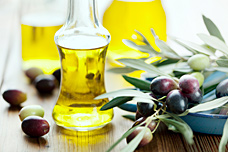|
Mediterranean Diet 101
You Don't Have to Be Greek to Enjoy the Benefits
Far from exotic, eating "Mediterranean" is less of a diet and more about a healthy approach to eating. A salad drizzled with olive oil and lemon juice, yogurt laced with walnuts and fresh fruit, whole-grain toast topped with avocado and sliced tomato. Sound delicious? These are all foods you would find on the Mediterranean Diet.
The Mediterranean Diet is based on foods that are traditionally found in countries surrounding the Mediterranean Sea (Egypt, Greece, Syria, Turkey and others). Vegetables, fruits, nuts, fish and olive oil are abundant. Meat, saturated fats and high-fat dairy are consumed in much smaller quantities.
Health Benefits
Multiple studies suggest that eating a Mediterranean-style diet may help contribute to a longer life, aid in weight control and cut the risk of cardiovascular disease. Plus, studies are now being done to see if this healthy approach to eating may also help to reduce the risk of:
- Rheumatoid arthritis
- Cancer
- Depression
- Alzheimer's disease
- Diabetes
- Metabolic syndrome
Researchers credit any health benefits to the abundance of plant foods, fish and healthy fats, combined with the low amount of high-fat animal foods.
Mediterranean Diet 101
You don't have to live on a Greek island to appreciate this wholesome meal plan. Here are the basics:
- Increase healthy fats (up to 30 percent of total calories) like those found in olive oil, nuts, avocados and fatty fish (salmon, sardines). These are all high in heart-healthy monounsaturated fat. Use these to replace saturated and trans fats found in fatty meats, some cheese and processed foods.
- Base your diet around fruits, vegetables, whole grains, beans, nuts and seeds. These provide hearty doses of antioxidants, loads of fiber and other vitamins and minerals that can help ward off disease.
- Choose lean protein sources like fish (two times or more per week), poultry and beans more often than pork and red meat (no more than twice per week).
- Enjoy yogurt and small portions of cheese daily.
- Drink wine in moderation (up to two glasses per day for men and one glass per day for women). But if you're not a drinker, don't start.
The diet allows for some sweets in small amounts. And remember that just because fats like olive oil and nuts are healthy, it does not give you license to eat them with abandon. These foods are still high in total calories. Keep fat intake to about 30 percent of total calories, which comes to about 65 grams on a 2000-calorie meal plan.
In the Kitchen
Switching to a Mediterranean way of eating is not only delicious, it's easy, too. Here are some suggestions for how to make the switch:
| If you now eat |
Try this instead |
| White toast with butter and jam |
Oatmeal with walnuts and fruit |
| Turkey on roll with mayo |
Turkey and hummus on whole-wheat pita |
| Large bowl of pasta with meat |
Small amount of pasta and meat mixed with lots of vegetables |
| Salad with ranch dressing |
Salad with olive oil and lemon juice |
| Pretzels or chips |
Nuts and/or fruit |
| Burger and fries |
Salmon and sweet potato |
Finally, don't forget the importance of daily physical activity. Check with your doctor before you increase your activity. Traditionally, exercise was a large part of these cultures' daily routine and can't be discounted as a player in disease prevention. By Jane Schwartz Harrison, RD, Staff Nutritionist, myOptumHealth
Sources
- Trichopoulou A, Bamia C, Trichopoulos D. Anatomy of health effects of Mediterranean diet: Greek EPIC prospective cohort study. British Medical Journal. 2009;338:2337. Accessed: 10/28/2009
- Walker C, Reamy B. Diets for cardiovascular disease prevention: what is the evidence? American Family Physician. 2009;79(7):571-578. Accessed: 10/28/2009
- Huang CL, Sumpio BE. Olive oil, the Mediterranean diet, and cardiovascular health. Journal of the American College of Surgeons. Accessed: 10/28/2009
|






